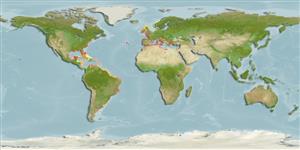Common names from other countries
Classification / Names / Names
Common names | Synonyms | Catalog of Fishes (gen., sp.) | ITIS | CoL | WoRMS
Environment: milieu / climate zone / depth range / distribution range
Ecology
Benthic; depth range 0 - 13 m (Ref. 3446). Temperate
Atlantic Ocean and the Mediterranean.
Length at first maturity / Size / Weight / Age
Maturity: Lm ? range ? - ? cm Max length : 40.0 cm TL male/unsexed; (Ref. 126605); max. published weight: 1.7 kg (Ref. 126605); max. reported age: 1.00 years (Ref. 126605)
Sea hares have annual life cycles (Ref. 126605).
Life cycle and mating behavior
Maturity | Reproduction | Spawning | Eggs | Fecundity | Larvae
Members of the order Anaspidea are mostly simultaneous hermaphrodites.
Sabelli, B., R. Gianuzzi-Savelli and D. Bedullli. 1990. (Ref. 7827)
IUCN Red List Status (Ref. 130435: Version 2024-1)
CITES status (Ref. 108899)
Not Evaluated
Not Evaluated
Threat to humans
Harmless
Human uses
| FishSource |
Tools
More information
Age/SizeGrowthLength-weightLength-lengthMorphologyLarvaeAbundance
Internet sources
Estimates based on models
Preferred temperature
(Ref.
115969): 10.3 - 24.1, mean 17.7 (based on 506 cells).
Vulnerability
Low vulnerability (21 of 100).
Price category
Unknown.
